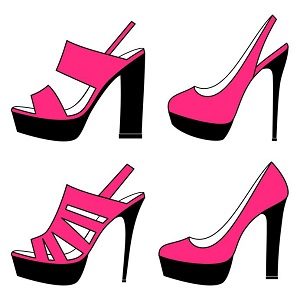A light hearted look at how to Walk in high heels
There is no right or wrong way to master the art of walking in high heels, especially to do it comfortably and confidently. The best advice is to know your feet and choose the right heel to begin with … and practice. Like riding a bike or learning to drive, many (mostly female admittedly) see walking in high heels as a right of passage. But, unlike learner drivers, at least if you do it poorly a twisted ankle is preferable to a twisted wreck and embarrassment might be your only injury (but who doesn’t delight at the professional catwalk model toppling off her ten-inch platform stilettos).
Choose the right heel to begin with
The Purchase: Arch enemies (How high the heel)

4 different styles of high heel shoes
Ducks may take to water, but there is nothing natural about walking in high heels. Your ability to walk in heels is as much about your feet as it is about the shoes. The shape of your foot (wide or narrow?), your arches (high, low or flat?) and the flexibility of your foot (think Ballerina toe balance) will help determine whether you can sustain or will succumb to a particular heel height. Should you care.
On a comfort basis, the height of your arches is inverse to the recommended heel height choice. If you have high arches, you’re better to choose a lower heel and vice versa (if a high heel is what your low arch feet want). Then there’s your toes! That sharp-looking pointed design comes at a price.
For most beginners, heels under 7.5cm will be an easier prospect to master. It’s a generally accepted definition that a ‘high’ heel kicks in at about 6.5cm, which is about the same height as your average lip balm stick. The highest heels might clock in at a whopping 25cm, which is a similar height to two tins of soup! The design of the heel, from a wedge to wide, tapered and stiletto will also affect your balance.
Practice
The Practice: Rome wasn’t walked in heels in a day
Try before you buy was never more appropriate when learning to walk in heels. As a small child you may have clopped around in your mother’s shoe collection during dress ups, so don’t be afraid to do it again. Alternatively, you might phone a friend or find inexpensive ‘trainer’ heels at an Opp Shop or online.
Practice with a friend. Familiarize yourself with a variety of surfaces and challenges. On stairs, the banisters are your only and best friend. Will you need to dance in heels? What if it rains? Could you run to an Uber on a wet footpath? Best not for a backyard bbq. There will be laughs. If you combine practice with alcohol you’ll also have an excuse for the wobble, grapple and topple. But remember, one size does not fit all – just ask Cinderella’s step sisters – and losing a shoe is never a good look.
If you are buying your first heel, best be realistic about your ability to walk in public, so choose something lower and with a wider heel for support and stability. A wedge might do this best, especially if you are after height but are new to heel life.
If your first heel purchase is for a particular event, there’s a deadline to meet. Decide and buy your heels well in advance so you can practice in various situations and the shoes can soften to your feet. If the fit isn’t perfect, try an insole or arch support. It’s ok to never lose sight of how much we love our high heels.
Walk the walk: If you must
Feet weren’t meant to wear heels. Walk around on your toes and human physiology starts to take effect. Put on heels and your body naturally tips forward. The strain to counter this is exerted on your back, through the core, thighs and calves. You’ve been warned.
But, if you must, there are some simple and accepted tips to follow. Before you walk, set yourself. Lean back and upright with slightly bent knees to distribute weight and soften impact. Take slow, small steps, with a heel to toe action and walk in as straight a line as you can by focusing on where you’re headed.
Enjoy the high life!


Recent Comments